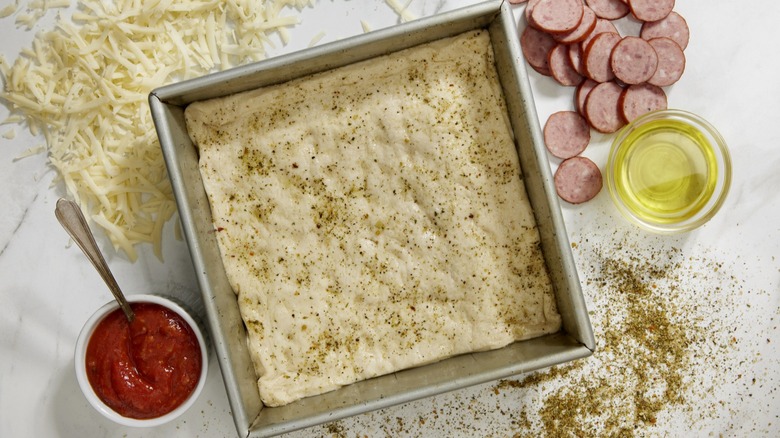The Style Of Pizza That's Easiest To Make Gluten-Free
We may receive a commission on purchases made from links.
If you're craving a hot, fresh pizza, you can definitely execute good results in your own kitchen, rather than ordering a gluten-free pie from a pizzeria and chancing potential cross-contamination with others containing wheat. Before rolling up your sleeves, you may wonder: Of the many different types of pizza, which style is the easiest to make gluten-free?
To find the answer, Food Republic talked to Serhan Ayhan, a pizza consultant at Krave It, home of the Dubai Chocolate dessert pizza. Krave It serves up gluten-free alternatives, and Ayhan said that you can "achieve success with gluten-free pan pizza styles like Detroit, Sicilian, and grandma." Each of these is baked on an oiled square or rectangular baking sheet of adequate depth (at least 1½ inches but preferably deeper for a Detroit, between 1½ and 2 inches for a Sicilian, and 1 inch for a grandma). For each type of pie, the dough is stretched out into the pan and does a final proofing there (though some pizza-makers don't allow additional rise time for grandmas, which are thinner and denser).
"Consider that what distinguishes wheat flour is its ability to create that gluten web that holds the whole dough together," Ayhan noted. "Without gluten, we need an alternative way to hold that structure, and a pan is a great tool for this. At the same time, pan pizzas are great for home pizza makers, as many home ovens are able to reach the proper baking temperatures."
Tips for the best flour and a well-executed dough
Serhan Ayhan also served up a tip for a good flour choice when making a home-baked gluten-free pizza. "The best flour for gluten-free pizzas (so far) has been Caputo's Fioreglute," he stated. "I suggest using this to make a gluten-free focaccia and use that as a base for making a Sicilian or (if you have the right pan) Detroit-style pizza. In terms of swapping it in, I would be sure to use a very high-hydration dough, up the yeast, and add some baking powder (really the only additional ingredient I would recommend, as there is no gluten to trap the gases)."
Failure to let the dough rest is one of the frequent mistakes everyone makes with their homemade pizza dough, and it's a step Ayhan advises never skipping. "Be sure to allow for the mixture to rest in the fridge before shaping," he said.
Once the dough has its cold proofing, it should be stretched by hand and shaped to fit the pan. Using a rolling pin is the biggest mistake that sabotages homemade pizza, and it shouldn't be done. There's a reason pizza chefs stretch dough by hand and by hand only. It not only aerates the pie's base, which is important for achieving a light, bubbly crust, but it ensures consistent thickness and shape for even cooking, as well as a proper texture that isn't overly dense.


